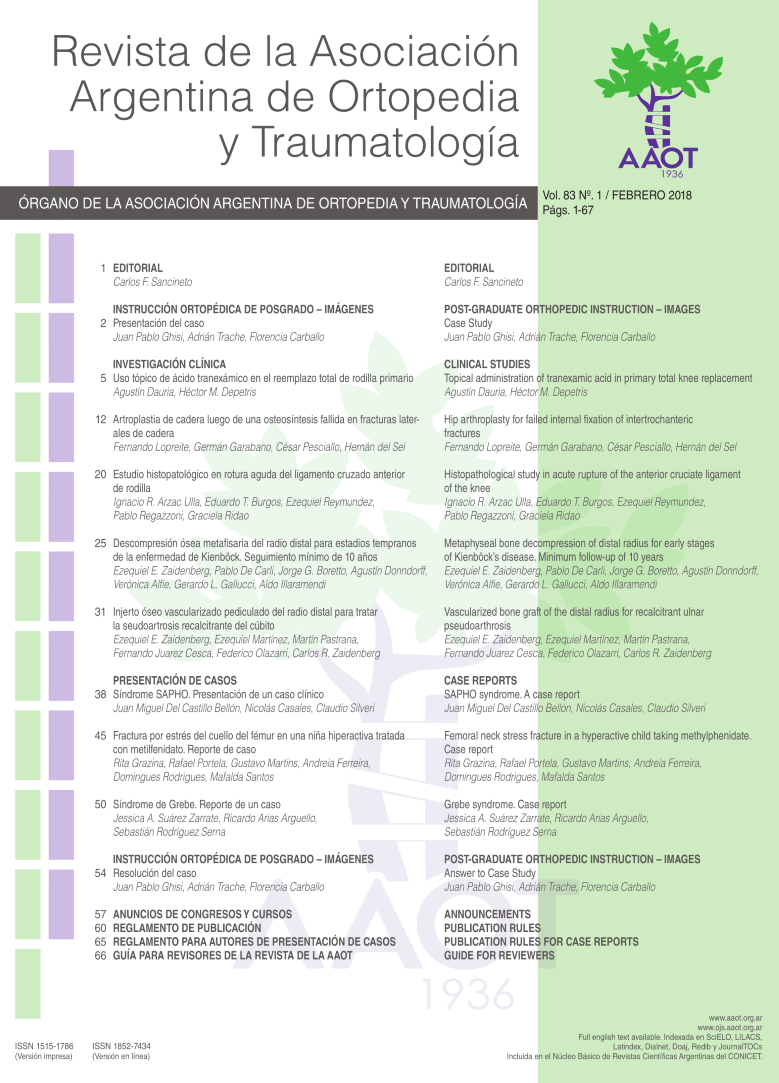Artroplastia de cadera luego de una osteosíntesis fallida en fracturas laterales de cadera. [Hip arthroplasty for failed internal fixation of intertrochanteric fractures.]
Contenido principal del artículo
Resumen
Descargas
Métricas
Detalles del artículo

Esta obra está bajo licencia internacional Creative Commons Reconocimiento-NoComercial-CompartirIgual 4.0.
La aceptación del manuscrito por parte de la revista implica la no presentación simultánea a otras revistas u órganos editoriales. La RAAOT se encuentra bajo la licencia Creative Commons 4.0. Atribución-NoComercial-CompartirIgual (http://creativecommons.org/licenses/by-nc-sa/4.0/deed.es). Se puede compartir, copiar, distribuir, alterar, transformar, generar una obra derivada, ejecutar y comunicar públicamente la obra, siempre que: a) se cite la autoría y la fuente original de su publicación (revista, editorial y URL de la obra); b) no se usen para fines comerciales; c) se mantengan los mismos términos de la licencia.
En caso de que el manuscrito sea aprobado para su próxima publicación, los autores conservan los derechos de autor y cederán a la revista los derechos de la publicación, edición, reproducción, distribución, exhibición y comunicación a nivel nacional e internacional en las diferentes bases de datos, repositorios y portales.
Se deja constancia que el referido artículo es inédito y que no está en espera de impresión en alguna otra publicación nacional o extranjera.
Por la presente, acepta/n las modificaciones que sean necesarias, sugeridas en la revisión por los pares (referato), para adaptar el trabajo al estilo y modalidad de publicación de la Revista.
Citas
2- Kyle RF. Fractures of the proximal part of the femur. JBJS Am 1994;76:924-950.
3- Lopreite F, Ratto J, del Sel H. Fractura lateral de cadera. Análisis de fallas y complicaciones con el clavo compresivo dinámico. Rev AAOT 2005;70(4):307-312.
4- Gonzalez GA. Salvataje de fallas en fracturas laterales de cadera tratadas con fijación interna. Tratamiento y resultados funcionales. Rev AAOT 2006;71(3):232-236.
5- Anglen JO, Weinstein JN. Nail or plate fixation of intertrochanteric hip fractures: changing pattern of practice. JBJS Am 2008;90:700-7.
6- Haidukewych GJ, Berry DJ. Hip artrhoplasty for salvataje of failed treatment of intertrochanteric hip fractures. JBJS Am 2003;85:899-905.
7- Haidukewych GJ, Israel TA, Berry DJ. Reverse obliquity of fractures of the intertrochanteric region of the femur. JBJS Am 2001;83:643-650.
8- Im GI, Shin YW, Song YJ. Potentiallity unstable intertrochanteric fractures. Journ Orthop Trauma 2005;19:5-9.
9- Madsen JE, Naess L, Aune AK, Stromsoe K. Dynamic Hip Screw with trochanteric stabilizing plate in the treatment of unstable proximal femoral fractures: a comparative study with Gamma nail and compression hip screw. Journ Orthop Trauma 1998;12:241-8.
10- Alvarez DB, Aparicio JP, Fernandez EL, Jimenez JP. Implant breakage, a rare complication with Gamma nail. A review of 843 fractures of the proximal femur treated with Gamma nail. Acta Orthop Belg 2004;70:435-443.
11- Haidukewych GJ, Berry DJ. Salvatage of failed internal fixation of intertrochanteric hip fractures. Clin Orthop 2003;412:184-8.
12- Said GZ, Farouk O, El-Sayed A, Said H. Salvatage of failed dynamic hip screw fixation of intertrochanteric fractures. Injury 2006;37:194-202.
13- Stoffelen D, Haentjens P, Reynders P, Opdecam P y cols. Hip arthroplasty for failed internal fixation of intertrochanteric and subtrochanteric fracturesin the elderly patient. Acta Orthop Belg 1994;60(Suppl 1):135-9.
14- Kligman M, Roffman M. Conversion total hip replacement after failed internal fixation of intertrochanteric fracture. Harefuah 1998;134:690-92.
15- Zhang B, Chiu KY, Wang M. Hip arthroplasty for failed internal fixation of intertrochanteric fractures. J Arthroplasty 2004;19:329-333.
16- D’Arrigo C, Perugia D, Carcangiu A, Monaco E, Ferreti A. Hip arthroplasty for failed treatment of proximal femoral fractures. Int Orthropaedics 2010;34:939-942.
17- Evans EM. The treatment of trochanteric fractures of the femur. JBJS Br 1949;31:190-205.
18- Harris WH. Traumatic arthritis of the hip after dislocation and
acetabular fracture: treatment by mold arthroplasty. An end-result study using a new method of result evaluation. JBJS Am 1969;51:737-40.
19- Barrack RL, Mulroy RD, Harris WH. Improved cementing techniques and femoral component loosening in Young patients with hip arthroplasty. A 12-year radiographic review. JBJS Br 1992;74:385-89.
20- Gruen TA, McNeice GM, Amstutz HC. Modes of failure of cemented stem-type femoral components: a radiographic analysis of loosening. Clin Orthop 1979;141:17-27.
21- DeLee JG, Charnley J. Radiological demarcation of cemented sockets in total hip replacement. Clin Orthop 1976;121:20-25.
22- Hodgkinson JP, Shelly P, Wrobleski BM. The correlation between roentgenographics appearance and operative findings at the bone-cement junction of the socket in Charnley low friction arthroplasty. Clin Orthop1988;228:105-9.
23- Harris WH, McCarthy JC, O’Neill DA. Femoral component loosening using contemporary techniques of femoral cement fixation. JBJS Am 1982;64:1063-8.
24- Engh CA, Glassman AH, Suthers KE. The case forporus-coated hip implants. The femoral side. Clin Orthop 1990;261-90-8.
25- Brooker AF, Bowerman JW, Robinson RA y cols. Ectopic ossification following total hip replacement. Incidence a method of classification. JBJS Am 1973;55:1629-32.
26- Haidukewych GJ, Berry DJ. Salvaje of failed treatment of hip fractures. J Am Acad Orthop Surg 2005;13:101-109.
27- Unnanuntana A, Goodman SB. Conversion total hip replacement after malunited intertrochanteric fracture: a technical note. Am J Orthop 2008;37(10):506-509.
28- Patterson BM, Salvati EA, Huo MH. Total hip arthropasty for complications of intertrochanteric fracture. A technical note. JBJS Am 1990;72:776-777.
29- Laffosse JM, Molinier F, Tricoire JL, Bonnevialle N, Chiron P, Puget J. Cementless modular hip arthroplasty as a salvataje operation for failed internal fixation of trochanteric fractures in elderly patients. Acta Orthop Belg 2007;73:729-736.
30- Abouelela AKH. Salvatage of failed trochanteric fracture fixation using the revitan curved cementless modular hip arthroplasty. Journ Arthop 2012;27(7):1382-1388.
31- Burstein AH, Currey J, Frankel VH y cols. The effect of screw holes. JBJS Am 1972;54:1143-8.
32- Edgerton BC, An KN, Morrey BF. Torsional strength reduction due to cortical defects in bone. Journ Orthop Res Am 1990;8:851-7.
33- Hammad A, Abdel AAL, Said HG, Bakr H. Total hip arthroplasty following failure of dynamic hip screw fixation of fractures of the proximal femur. Acta Orthop Belg 2008;74:788-792.
34- Hsieh PH, Chang YH, Chen SH, Shih CH. Staged arthroplasty as salvataje procedure for deep hip infection following intertrochanteric fracture. Int Orthop 2006;30(4):228-232.

